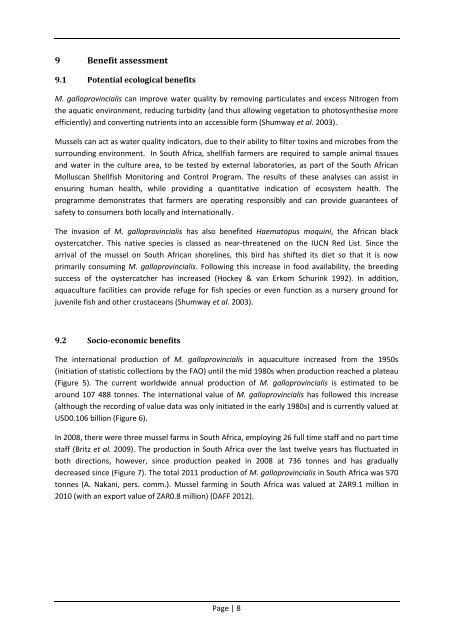Mediterranean mussel Mytilus galloprovincialis - Department of ...
Mediterranean mussel Mytilus galloprovincialis - Department of ...
Mediterranean mussel Mytilus galloprovincialis - Department of ...
You also want an ePaper? Increase the reach of your titles
YUMPU automatically turns print PDFs into web optimized ePapers that Google loves.
9 Benefit assessment9.1 Potential ecological benefitsM. <strong>galloprovincialis</strong> can improve water quality by removing particulates and excess Nitrogen fromthe aquatic environment, reducing turbidity (and thus allowing vegetation to photosynthesise moreefficiently) and converting nutrients into an accessible form (Shumway et al. 2003).Mussels can act as water quality indicators, due to their ability to filter toxins and microbes from thesurrounding environment. In South Africa, shellfish farmers are required to sample animal tissuesand water in the culture area, to be tested by external laboratories, as part <strong>of</strong> the South AfricanMolluscan Shellfish Monitoring and Control Program. The results <strong>of</strong> these analyses can assist inensuring human health, while providing a quantitative indication <strong>of</strong> ecosystem health. Theprogramme demonstrates that farmers are operating responsibly and can provide guarantees <strong>of</strong>safety to consumers both locally and internationally.The invasion <strong>of</strong> M. <strong>galloprovincialis</strong> has also benefited Haematopus moquini, the African blackoystercatcher. This native species is classed as near-threatened on the IUCN Red List. Since thearrival <strong>of</strong> the <strong>mussel</strong> on South African shorelines, this bird has shifted its diet so that it is nowprimarily consuming M. <strong>galloprovincialis</strong>. Following this increase in food availability, the breedingsuccess <strong>of</strong> the oystercatcher has increased (Hockey & van Erkom Schurink 1992). In addition,aquaculture facilities can provide refuge for fish species or even function as a nursery ground forjuvenile fish and other crustaceans (Shumway et al. 2003).9.2 Socio-economic benefitsThe international production <strong>of</strong> M. <strong>galloprovincialis</strong> in aquaculture increased from the 1950s(initiation <strong>of</strong> statistic collections by the FAO) until the mid 1980s when production reached a plateau(Figure 5). The current worldwide annual production <strong>of</strong> M. <strong>galloprovincialis</strong> is estimated to bearound 107 488 tonnes. The international value <strong>of</strong> M. <strong>galloprovincialis</strong> has followed this increase(although the recording <strong>of</strong> value data was only initiated in the early 1980s) and is currently valued atUSD0.106 billion (Figure 6).In 2008, there were three <strong>mussel</strong> farms in South Africa, employing 26 full time staff and no part timestaff (Britz et al. 2009). The production in South Africa over the last twelve years has fluctuated inboth directions, however, since production peaked in 2008 at 736 tonnes and has graduallydecreased since (Figure 7). The total 2011 production <strong>of</strong> M. <strong>galloprovincialis</strong> in South Africa was 570tonnes (A. Nakani, pers. comm.). Mussel farming in South Africa was valued at ZAR9.1 million in2010 (with an export value <strong>of</strong> ZAR0.8 million) (DAFF 2012).Page | 8
















